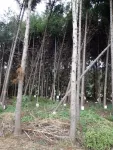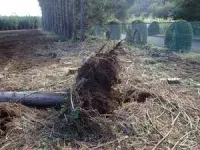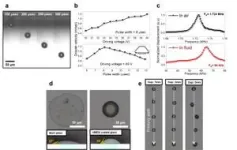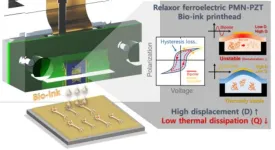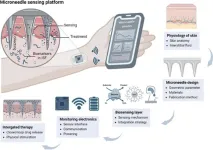Destructive winds during storms and cyclones often cause tree failures, especially through uprooting and stem breakage. However, how trees respond to wind under various forest configurations and weather conditions remains unclear. A recent study on Cryptomeria japonica plots shows that trees dissipate wind energy by switching between two swaying behaviors at specific wind speeds, offering insights that may help in improved forest management to minimize damage caused by storms.
Extreme weather events, such as tropical and extratropical cyclones and tornadoes, can cause widespread damage to forests, leading to environmental and financial losses. When trees fall during these storms, ecosystems might be disrupted, increasing forest management costs. As climate change worsens, severe storms are expected to become more frequent, making it crucial to understand how forests respond to wind stress.
Grasping the mechanisms behind tree failure is key to developing strategies for mitigation. While previous studies have explored how trees react to wind, it is unclear whether these responses remain consistent across different forest configurations—characterized by tree spacing and density—and weather conditions.
In this vein, a team of researchers led by Associate Professor Kana Kamimura from the School of Science and Technology at Shinshu University, Japan, investigated tree movements under various forest configurations and weather conditions, including how trees resist winds. The research team included Kazuki Nanko, Asako Matsumoto, and Saneyoshi Ueno from the Forestry and Forest Products Research Institute, Japan, and Barry Gardiner from the University of Freiburg, Germany, and the Institut Européen de la Forêt Cultivée, France. This paper was made available online on August 27, 2024, and was published on November 1, 2024, in Volume 571 of Forest Ecology and Management.
Explaining their motivation behind the study, Prof. Kamimura says, “Several techniques have been developed to predict wind damage. However, they largely depend on empirical data and parameters, and overlook how wind damage occurs. Our research aims to shed light on how winds directly impact trees and how trees reduce the stress from winds to survive.”
To achieve this, researchers set up two experimental plots of Cryptomeria japonica trees, commonly known as the Japanese cedar, in November 2017 in the experimental forests operated by the Forestry and Forest Products Research Institute, Kasumigaura City, Japan. In the first plot, P-100 consisted of 3,000 trees per hectare, creating a dense forest. In the second plot, P-50, half of the trees were removed for this research, leaving 1,500 trees per hectare to mimic thinning practices. Over two years, the team monitored 24 trees in the dense plot and 12 in the thinned plot, using trunk-mounted sensors to track tree sway during various wind conditions. The monitoring period included multiple typhoons, such as Typhoon Trami, in 2018, which caused significant damage to the thinned plot.
The researchers found that cedar trees exhibit two distinct swaying patterns depending on wind speed. In light winds, the trees swayed at around 2 to 2.3 cycles per second, with their branches absorbing much of the wind energy, protecting the trunks and roots from wind stress. However, at higher wind speeds, the trees shifted to a slower swaying pattern of 0.2 to 0.5 cycles per second. In this phase, the whole tree swayed together, transferring force across the trunk and roots, increasing the probability of breakage or uprooting.
Interestingly, the transition between these two swaying modes occurred at different wind speeds, depending on the forest density. In the dense plot, the trees switched patterns at wind speeds between 1.79 and 7.44 meters per second. In contrast, in the thinned plot, the transition occurred at slightly lower wind speeds, ranging from 1.57 to 5.63 meters per second.
Using an uprooted tree as a reference, researchers assessed the resistance to damage in the thinned P-50 over a 10-minute period during Typhoon Trami. They found that the actual resistance was only 48% of the expected resistance estimated through controlled tree-pulling experiments.
Prof. Kamimura elaborates, “The 52% difference between actual and expected resistance values was likely due to the roots weakening because of strong winds, even before the winds became more severe. This root fatigue occurred because the trees moved more due to less support from nearby trees and more wind penetrating the plot.” This also explains why the trees in the dense P-100 were not damaged during Typhoon Trami.
This study offers valuable insights for balancing thinning with wind resistance in forest management to support sustainable forestry practices, and help forests withstand extreme climate changes. While thinning promotes tree growth, it can also make forests more vulnerable to storms, especially soon after thinning. Prof. Kamimura concludes, "With more frequent storms in a changing climate, forest management practices must adapt to maintain resilience.”
###
About Shinshu University
Shinshu University is a national university founded in 1949 and located nestling under the Japanese Alps in Nagano, known for its stunning natural landscapes. Our motto, "Powered by Nature—strengthening our network with society and applying nature to create innovative solutions for a better tomorrow," reflects the mission of fostering promising creative professionals and deepening the collaborative relationship with local communities, which leads to our contribution to regional development by innovation in various fields. We are working on providing solutions for building a sustainable society through interdisciplinary research fields: material science (carbon, fiber, and composites), biomedical science (for intractable diseases and preventive medicine) and mountain science, and aiming to boost research and innovation capability through collaborative projects with distinguished researchers from the world. For more information, visit https://www.shinshu-u.ac.jp/english/ or follow us on X (Twitter) @ShinshuUni for our latest news.
About Associate Professor Kana Kamimura from Shinshu University
Dr. Kana Kamimura is an Associate Professor in the Department of Agricultural and Life Sciences at Shinshu University, Japan. Her research focuses on wind damage in forests based on spatial, biomechanistic, and statistical approaches. Currently, she is leading a project of exploring alternative approaches to understanding trees’ dynamic behavior in forests. With over 6,290 reads and 813 citations to her name, Kamimura has made significant contributions to understanding forest resilience and sustainability. Her work aims to support effective forestry practices in the face of climate change and extreme weather events.
END
